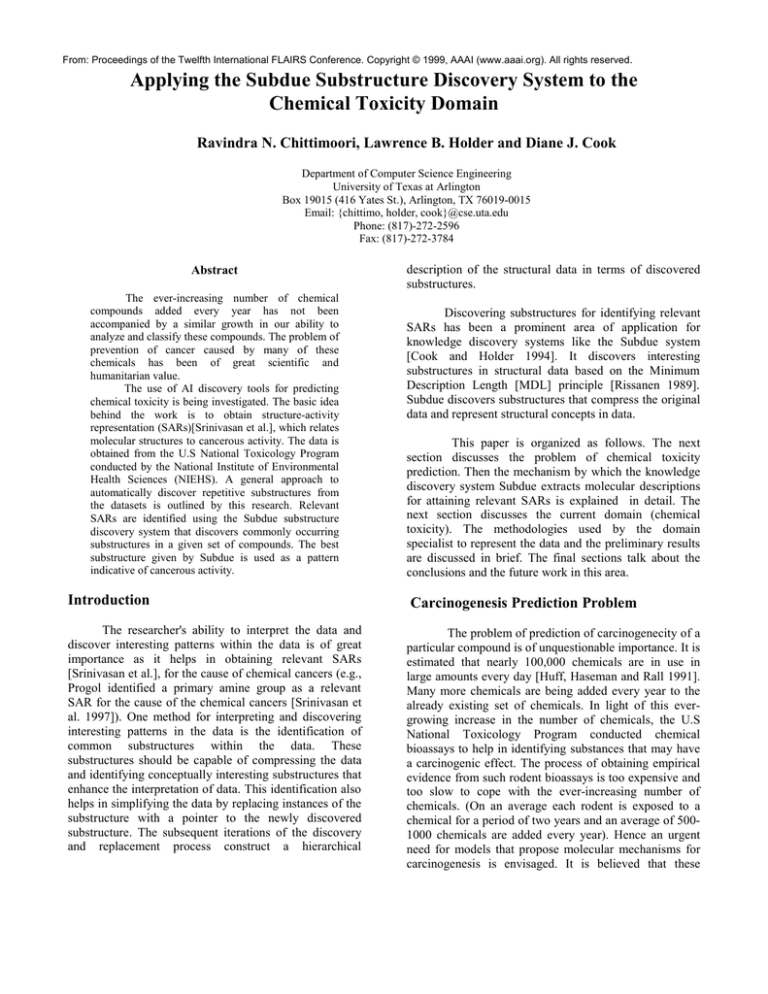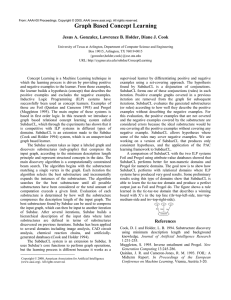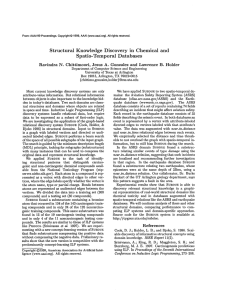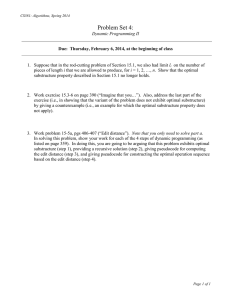
From: Proceedings of the Twelfth International FLAIRS Conference. Copyright © 1999, AAAI (www.aaai.org). All rights reserved.
Applying the Subdue Substructure Discovery System to the
Chemical Toxicity Domain
Ravindra N. Chittimoori, Lawrence B. Holder and Diane J. Cook
Department of Computer Science Engineering
University of Texas at Arlington
Box 19015 (416 Yates St.), Arlington, TX 76019-0015
Email: {chittimo, holder, cook}@cse.uta.edu
Phone: (817)-272-2596
Fax: (817)-272-3784
Abstract
The ever-increasing number of chemical
compounds added every year has not been
accompanied by a similar growth in our ability to
analyze and classify these compounds. The problem of
prevention of cancer caused by many of these
chemicals has been of great scientific and
humanitarian value.
The use of AI discovery tools for predicting
chemical toxicity is being investigated. The basic idea
behind the work is to obtain structure-activity
representation (SARs)[Srinivasan et al.], which relates
molecular structures to cancerous activity. The data is
obtained from the U.S National Toxicology Program
conducted by the National Institute of Environmental
Health Sciences (NIEHS). A general approach to
automatically discover repetitive substructures from
the datasets is outlined by this research. Relevant
SARs are identified using the Subdue substructure
discovery system that discovers commonly occurring
substructures in a given set of compounds. The best
substructure given by Subdue is used as a pattern
indicative of cancerous activity.
Introduction
The researcher's ability to interpret the data and
discover interesting patterns within the data is of great
importance as it helps in obtaining relevant SARs
[Srinivasan et al.], for the cause of chemical cancers (e.g.,
Progol identified a primary amine group as a relevant
SAR for the cause of the chemical cancers [Srinivasan et
al. 1997]). One method for interpreting and discovering
interesting patterns in the data is the identification of
common substructures within the data. These
substructures should be capable of compressing the data
and identifying conceptually interesting substructures that
enhance the interpretation of data. This identification also
helps in simplifying the data by replacing instances of the
substructure with a pointer to the newly discovered
substructure. The subsequent iterations of the discovery
and replacement process construct a hierarchical
description of the structural data in terms of discovered
substructures.
Discovering substructures for identifying relevant
SARs has been a prominent area of application for
knowledge discovery systems like the Subdue system
[Cook and Holder 1994]. It discovers interesting
substructures in structural data based on the Minimum
Description Length [MDL] principle [Rissanen 1989].
Subdue discovers substructures that compress the original
data and represent structural concepts in data.
This paper is organized as follows. The next
section discusses the problem of chemical toxicity
prediction. Then the mechanism by which the knowledge
discovery system Subdue extracts molecular descriptions
for attaining relevant SARs is explained in detail. The
next section discusses the current domain (chemical
toxicity). The methodologies used by the domain
specialist to represent the data and the preliminary results
are discussed in brief. The final sections talk about the
conclusions and the future work in this area.
Carcinogenesis Prediction Problem
The problem of prediction of carcinogenecity of a
particular compound is of unquestionable importance. It is
estimated that nearly 100,000 chemicals are in use in
large amounts every day [Huff, Haseman and Rall 1991].
Many more chemicals are being added every year to the
already existing set of chemicals. In light of this evergrowing increase in the number of chemicals, the U.S
National Toxicology Program conducted chemical
bioassays to help in identifying substances that may have
a carcinogenic effect. The process of obtaining empirical
evidence from such rodent bioassays is too expensive and
too slow to cope with the ever-increasing number of
chemicals. (On an average each rodent is exposed to a
chemical for a period of two years and an average of 5001000 chemicals are added every year). Hence an urgent
need for models that propose molecular mechanisms for
carcinogenesis is envisaged. It is believed that these
models would cut down the costs, reduce dependence on
laboratory animals and generate reliable toxicity
predictions for all kinds of chemicals.
Overview of SUBDUE
The Subdue system discovers the substructures in
the databases that compress the original data and
represent structural concepts in the data. The best
substructure is found after multiple passes by replacing
the previously discovered substructures in each pass. A
substructure is a connected subgraph within the graphical
representation. The discovery system represents structural
data as a labeled graph. Objects in the data map to
vertices or small subgraphs in the graph, and relationships
between objects map to directed or undirected edges in
the graph. This graphical representation serves as input to
Subdue (e.g., see figure 1). The discovery algorithm used
by Subdue is a computationally constrained beam search.
The algorithm begins with the substructure matching a
single vertex in the graph. The algorithm selects the best
substructure in each iteration and incrementally expands
the instances of a substructure. An instance of a
substructure in an input graph is a set of vertices and
edges from the input graph that match, graph
theoretically, to the graphical representation of the
substructure. These new substructures become candidates
for further expansion. This algorithm searches for the best
substructure until all possible substructures have been
considered or the total amount of computation exceeds a
given limit. Evaluation of each substructure is determined
by how well the substructure compresses the description
length of the concerned database.
To identify substructures that occur often in data
but not always in the same form, Subdue uses a
computationally bounded inexact graph match [Bunke
and Allerman 1983]. The inexact substructure discovery
can be used to discover interesting structures in the input
data, whose instances are found either in the same form or
in a slightly convoluted form. Subdue's search can be
guided towards appropriate substructures for a particular
domain (in our case the chemical toxicity domain) by the
inclusion of background knowledge (e.g., known relevant
SARs).
Chemical Toxicity Domain
A database of more than 300 chemicals has been
created due to the tests conducted by the U.S. National
Toxicology Program (NTP) [niehs]. These compounds are
determined to be carcinogenic or noncarcinogenic. Levels
of evidence of carcinogenecity are obtained from the
incidence of tumors on long term exposure to chemicals
using rats and mouse strains as predictive surrogates for
humans. The NTP assigned the following levels of
evidence for the compounds: CE – clear evidence of
cancerous activity, SE – some evidence of cancerous
activity, E – equivocal evidence of cancerous activity and
NE – no evidence of cancerous activity. Conventional
regression based techniques ([Kubini 1993]) cannot be
applied to model the compounds in the NTP database
because of the diversity of the compounds present. Hence
the need for some discovery algorithms that can discover
interesting, useful concepts even in the most varying
domains.
The datasets in the NTP database contain
information about more than 300 chemical compounds
that are either carcinogenic or noncarcinogenic. Primarily
there are 298 chemical compounds whose carcinogenecity
is known. This comprises the training set of the Subdue
program. There are 69 compounds whose carcinogenecity
is not known. This comprises the experimental set of the
Subdue program. The information in these sets relates to
the molecular structures of the compounds, and includes
the atoms, bonds and domain specific knowledge about
various groups like alcohol, amine, amino, benzene, ester,
ether, ketone, methanol, methyl, nitro, phenol and sulfide.
The representation also contains information about the
compound test results (+/-) on the various properties of
carcinogenecity like Ames test, Chromex, Chromaberr,
Drosophilia, Mouse-Lymph, Salmonella Assay. The aim
of this research project is to obtain SARs despite the
diversity present among the compounds.
Methodology
The training set is further divided into positive
examples and negative examples. Subdue is applied to the
positive (cancerous) and the negative (non-cancerous)
examples separately and the best substructures are
identified in each of these training sets. The resultant best
substructures from each of the two training sets (positive
and negative) are compared. The substructures that occur
in the positive examples but not in the negative examples
are identified. These identified substructures are used as
the pattern indicative of cancerous activity.
The toxicity of the chemicals in the experimental
set can be determined by the following approaches. One
approach is to apply Subdue individually to the
compounds in the experimental set and record the best
substructure in each of the compounds. Based on the
judgement of the domain specialist (comparing the best
substructure returned by Subdue with the substructures
identified from the training set) the compound in the
experimental set is determined to be carcinogenic or
noncarcinogenic. Presently we are using this approach in
identifying the carcinogenicity of compounds in the
experimental set. The second approach is to include
bonds between the atoms are represented as undirected
edges between the vertices. Domain knowledge is
incorporated into Subdue to guide the discovery process.
Various groups like methyl, benzene, amino etc., each are
represented as a vertex in each compound and have
directed edges to all the atoms in a compound, which
participate in the group. Properties like Salmonella assay
and Ames test are each represented as a vertex in each
compound and have directed edges to all the atoms in the
compound with the string label on each of these edges
specifying whether the compound tested positive or
negative on this property. Figure 1 shows a sample graph.
To capture the diversity present in the atoms (atom name,
atom type, and partial charge), each of the atoms is
represented as a separate node with directed edges to the
name of the atom (n), type (t) and partial charge (p). The
relationship between atoms (i.e. bonds) is represented as
undirected edges.
substructures identified in the training set as predefined
substructures for Subdue in its search on the experimental
set. Subdue will first search the input graph of the
compound for instances of the predefined substructures,
using inexact graph matches. Instances that match within
the inexact match threshold are subsequently expanded.
The domain specialist determines the carcinogenecity or
noncarcinogenecity of a compound in the experimental
set depending on how well the predefined substructure
helped in compressing the description length of the
compound. The third approach is to check if the
discovered substructure SAR appears anywhere in the
compound to be classified. Once unique SARs are
discovered, the presence of only one substructure might
be enough evidence to predict carcinogenecity.
The input to the Subdue program is the graphical
representation of all the chemical compounds. Each of the
atoms in a compound is represented as a vertex and the
10
c
t
n
32
10
0.062
c
p
1
atom
p
0.063
t
n
p
32
p
atom
10
c
0.032
t
n
atom
p
pp
h
p
p
AMES
7
n
7
0.064
t
p
atom
p
h
p
n
7
10
0.062
t
atom
1
c
t
n
0.063
p
atom
Figure 1: Results of Subdue on part of chemical compound.
From: Proceedings of the Twelfth International FLAIRS Conference. Copyright © 1999, AAAI (www.aaai.org). All rights reserved.
10
c
0.062
t
n
p
atom
Figure 2: Substructure S1 discovered by Subdue.
10
c
0.063
t
n
S1
p
atom
1
Figure 3: Substructure S2 discovered by Subdue.
10
0.062
c
t
n
p
atom
Figure 4: Substructure with 4 vertices discovered by Subdue.
10
c
t
n
atom
10
c
0.062
p
1
0.063
n
t
p
atom
Figure 5: Substructure with 8 vertices discovered by Subdue.
Subdue discovers substructure S1 in the
compound as in figure 2 above. S1 when used to compress
the sample graph further, finds substructure S2 as in figure
3. Subdue generates a similar hierarchical description of
structures with such repeated applications.
Results
Subdue has been successful in discovering small
substructures. Figure 4 is an example of a substructure
discovered. Subdue was successful in discovering the
exact number of instances of this substructure in the
positive (cancerous) examples. Figure 5 is an
improvement over figure 4. Subdue discovered a
substructure with 8 vertices. Efforts are being made in
guiding Subdue to discover more complex substructures
that might help in relating a compound with
carcinogenecity.
The parameter settings for Subdue help in
guiding the search towards a more specific result. The
parameters that might affect the results of Subdue most
are the threshold parameter (the fraction of the size of an
instance by which the instance can be different) and the
size parameter (size of considered substructures). By
specifying a value for the threshold parameter, the inexact
graph match can be done. If the domain specialist believes
that the partial charge value need not be exactly matched,
but can vary by a range of (+/-) x, then Subdue can be
tuned to perform the inexact graph match by specifying a
value for the threshold parameter. The size of the
substructure considered by Subdue can be specified by the
size parameter that has a lower bound and an upper
bound. If the domain specialist believes that the
substructure discovered by Subdue is too inconsequential
or too big to find any relevant SARs, then appropriate
values can be specified to guide Subdue in its discovery.
We are optimistic that relevant SARs that indicate
carcinogenic activity can be identified by Subdue.
Conclusions
The prediction of carcinogenecity and the
modeling of diverse chemical compounds is of
unquestionable importance. The data mining algorithms
capable of handling the increasing structural component
of today’s databases can achieve this. Subdue, a data
mining algorithm, is specifically designed to discover
increasingly interesting and repetitive patterns within the
data that relates molecular structure to cancerous activity.
In this paper, the methodologies of representing
the chemical toxicity domain are discussed at length. The
initial results of Subdue are explained and an effort is
made to explain the eventual capability of Subdue to
discover a pattern that distinguishes carcinogenic and
noncarcinogenic compounds.
Future Work
Future research aims at describing the possible
relationships between molecular structure of a compound
on the one hand, and biological and toxicological
processes on the other. Subdue is presently in an
experimental phase. Making use of parallel and
distributed resources can significantly improve the runtime performance of data-intensive and compute-intensive
discovery programs such as Subdue. We are currently
evaluating the benefits of applying a parallel version
[Galal, Cook and Holder 1997] of Subdue on the chemical
toxicity domain.
References
[Srinivasan et. al] A. Srinivasan, S.H. Muggleton, R.D.
King and M.J.E. Sternberg. The Predictive Toxicology
Evaluation Challenge.
http://www.comlab.ox.ac.uk/oucl/groups/machlearn/PTE/
[Cook and Holder 1994] D.J.Cook and L.B.Holder.
Substructure Discovery Using Minimum Description
Length and Background Knowledge. In Journal of
Artificial Intelligence Research, Volume 1, pages 231255, 1994.
[Rissanen 1989] J.Rissanen. Stochastic Complexity in
Statistical Inquiry. World Scientific Publishing Company,
1989.
[Huff, Haseman and Rall 1991] J.E.Huff, J.K.Haseman,
and D.P.Rall. Scientific concepts, value and significance
of chemical carcinogenesis studies. Ann Rev Pharmacol
Toxicol, 31:621-652, 1991.
[Bunke and Allerman 1983] H.Bunke and G.Allermann.
Inexact graph matching for structural pattern recognition.
Pattern Recognition Letters, 1(4):245-253, 1983.
[niehs]
http://ntpserver.niehs.gov/main_pages/about_NTP.html
[Kubini 1993] H.Kubini. QSAR: Hansch Analysis and
Related Approaches. VCH, New York, 1993.
[Galal, Cook and Holder 1997] G.Galal, D.J.Cook and
L.B.Holder, Improving Scalability in a Knowledge
Discovery System by Exploiting Parallelism. In the
Proceedings of the Third International Conference on
Knowledge Discovery and Data Mining, pages 171-174.
1997.







